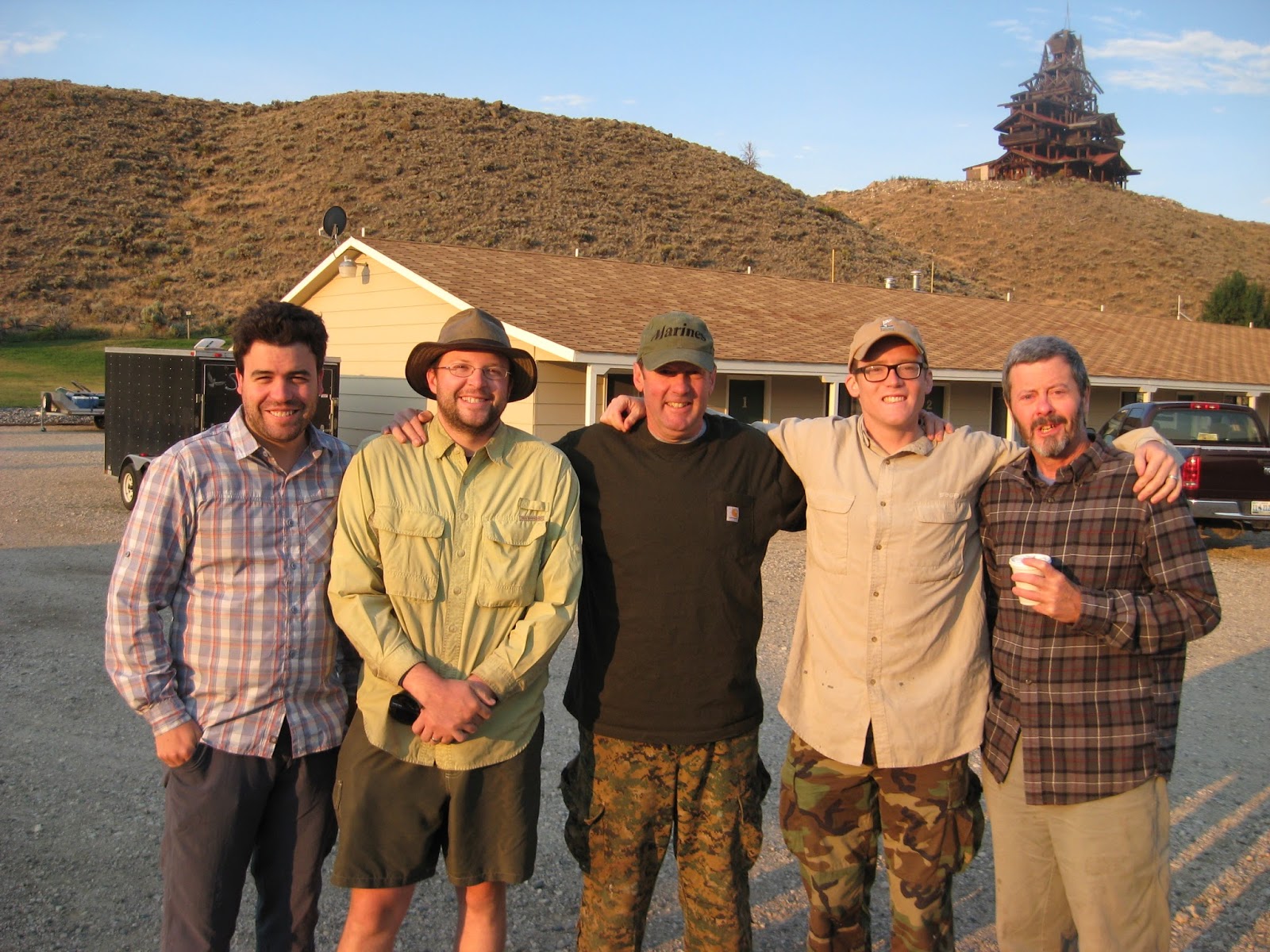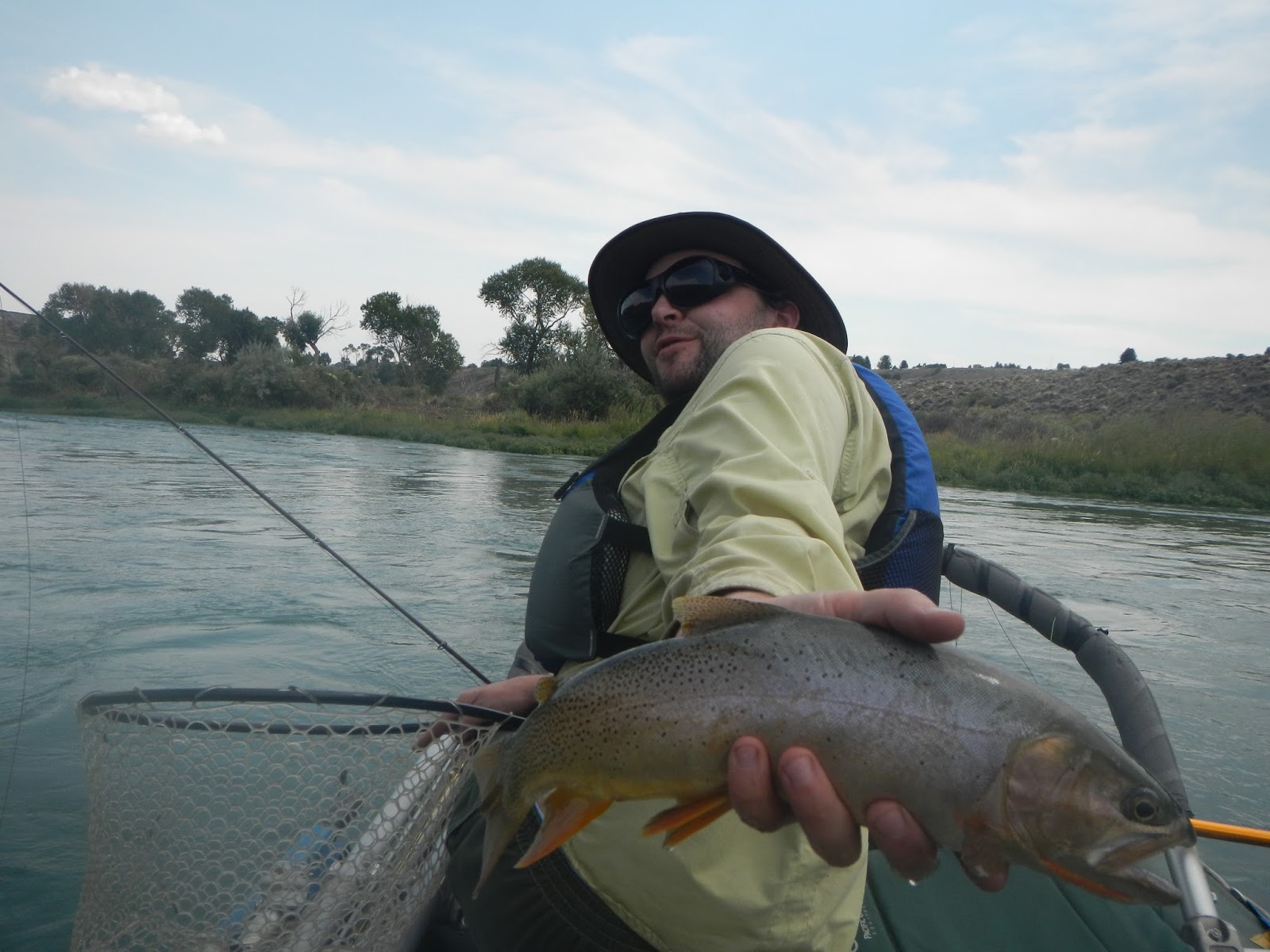9-18 August 2013
In a moment that she may have regretted later, my wife
suggested that I take a week-long “baby-moon” fishing trip before our first
child comes in December. Thus began the planning between my best friends from
high school, father and his friend that lead to a fishing trip that spanned the Shoshoni
National Forest in northwest Wyoming.
The fishing trip was centered around a four-day pack trip
into the Washakie Wilderness in the Shoshoni National Forest. We arrived in
Cody on a Saturday, four days before the pack trip, and fished the Shoshoni and
other surrounding creeks.
Cody, WY
We chose Cody as our base to fish because it was near the
outfitter who was packing us in. In retrospect, we could have stayed closer to
where the outfitter was packing us in. However, Cody was a great base to fish
from. It has a Wal-Mart and a Sierra Trading Post, plenty of restaurants and a
nice downtown. Cody also has a rodeo every night from June through August at 8
pm.
We stayed at the Green River Inn which was about 20 miles
west of Cody. The best landmarks are the Last Chance Gas Station (last chance
for gas before Yellowstone National Park) and this strange looking house. The
house, which I initially took for some strange mining structure, was the
18-year project of some engineer who lived in Cody. He apparently died in a
fall from his little structure.
For restaurants we tried the Trail Shop Motel twice and the
Yellowstone Café. The Trail Shop Motel was an unexpected gourmet oasis. Both
times I got the spinach fettuccini with vegetables. It was very filling and had
a great spicy kick. Both places had small, but reasonable draft menus. The
Trail Shop had the Sweetgrass APA and New Belgium’s 1554. The Yellowstone Cafe
had a nice bison burger.
While there are two fly shops in Cody, the North Fork
Anglers were the only ones that were open while we were there. The lady was
very friendly and offered great advice. While it is not where I would go to
gear-up for a trip, it is definitely the place to stop and get your flies. For
this trip I relied heavily on:
·
Hoppers
·
Grey humpies
·
N. Fork Specials (any
golden stonefly)
·
Prince nymphs
·
Copper johns
 |
| The fly on top is a prince nymph which was decimated by about 30 fish. The one one bottom is what is used to look like. |
Boulder to Cody
It takes about 8.5 hours to get from Boulder to Cody. You
pass by the large Sierra Trading Post in Cheyenne which is worth a stop for
some last-minute outfitting of any camping and fishing gear. For lunch we
stopped at the Wonder Bar in Casper. This is a fun brewpub with a good spread
of food. Justin and I tried the fish tacos. They only had four house beers when
we were there, I tried their IPA and Red. The red had a nice hoppiness to it
and a bit of lingering yeast flavor. It was also only $4.50 for 24 ozes.
Once your leave Casper there are not too many other towns. We
left Cody on Route 26 and drove through high desert country. We finally got a
break from the high-country desert when we turned north on Route 20 and went
through a beautiful canyon of the Wind River above the Boysen Reservoir. Once you reach Thermopois (which is lacking in
Spartans) you still have an hour-and-a-half.
Floating the Shoshoni
Length:10 miles
Time: 6-7 hours (fishing hard)
Water: 275 cfs
Launches / Take-outs:
·
Old Town Trail: 44°
31.107'N 109° 6.793'W
·
Town landing: 44° 32.031'N 109°
3.760'W
·
Corbett Bridge: 44°
34.615'N 108° 58.351'W

Justin and I went in on a 13-foot Super Puma a few years
ago and it has been a great boat. We launched at the Trail Town Road (on Google
Maps it’s called Demaris Dr, but it is behind an Old Trail Town billboard).
This landing has a gate to prevent guide services from using it so you have to
carry your boat down. The first 10-15 minutes of floating also reek of sulfur
and have lousy fishing. However, as compensation for the smell you have
beautiful red-rock canyons and once you get about 10-15 minutes downstream, the
fishing is great.
The take-out at Corbett Bridge is on the left and not too
hard to get to. The river itself has some class II and light class III, but it
not too bad in a raft. We would have floated the North Fork of the Shoshoni as
well, but the water was too low in August.
The best strategy that we found was to go through the
runs and then eddy out. The fish seemed to be near the banks. While we were
there they loved copper johns in the upper stretch. We caught mostly
Yellowstone Cutts and 'bow in the upper portion.
About lunchtime we would stop at the town landing which
was at the edge of 12th street. Once day we even walked up into town
for lunch.
Once we got below the town landing the fishing was always
slower. Here we found streamers to be the best bet. A sink-tip line definitely
improved our odds. Of course, it also could have been the time of day, since we
allways fished this stretch in the afternoon. We also seemed to catch more
brown in this section. The average size for this whole stretch was around
12-14”.
Wade fishing around Cody
Eagle Creek Trailhead: 44° 28.146'N 109° 53.232'W
Fishhawk Creek Trailhead: 44° 26.973'N 109° 50.031'W
Clearwater Creek Trailhead: 44° 27.825'N 109° 40.258'W
My father and his friend fished Eagle & Fishhawk Creeks
the first two days while my friends and I were floating the Shoshoni. They
found both to have good flows and good trails beside them. They caught mostly
brookies in these two creeks and mostly on hoppers (although that was the
primary dry fly they fished). My father also had good luck with Spinners.
All of us tried Clearwater Creek. This one was thinner
than Eagle or Fishhawk and was more pocket water fishing. There was also a good
trail that followed the stream. We trail crosses the stream about a mile in and
then re-crosses the stream pretty quickly. We hiked about 2.5 miles in before
we started fishing (to try and get away from the pressure) The fishing was not
spectacular, but it was fairly steady. Most good drifts with a dry-dropper
(Size 14 stimulator – size 14-16 pheasant tail) usually produced rainbows in
the six to eight-inch range. My final fish of the day was a surprising 14”
brookie caught right above the first stream crossing.
My father and his friend tried Sheep Creek in the
afternoon but found it rather overgrown and with little to show for fish.
Pack Trip Camping
Trailhead: 44° 6.501'N 109° 21.097'W
Time: Cody to Trailhead ~2 hours
Trail to campsite: 11.6 miles, 4 hours on the horse (~3
mph)
While not something that I would do all the time, doing a
pack trip is a really fun way to fish. Our guide, Karl, packed the mules, set
up camp, cooked and cleaned. All we had to do was keep on the horse and fish
(generally not at the same time).
 |
| Our guide, Karl, leading the pack mules |
Traveling by horse to your camp or fishing hole really
makes you feel like you are in the west. It is also a literal pain in the butt.
And knees. Karl said that if you knees hurt your sturrups are too high. If your
butt hurts the sturrups are too low. If both hurt you have them set right. The
other key was to keep the horse up with the pack mules. If you let it eat grass
or fall behind you had to endure the trotting.
Fishing the Greybull
The Greybull has a wide range of looks. One day we fished
a canyon section with some great deep runs. Some of the best runs had almost
twenty 10 to 12-inch fish. Another day we fished the braided section near where
Venus Creek comes in. The fish were not quite and big and there were not quite
as many per hole. Finally, we tried another canyon section farther upstream. We
fished this section early in the morning and had much sparser luck. After we
got back our guide noted that the fishing is slow until the sunlight hits the
canyon.
 |
| Canyon stretch above our campsite. You hike about another half miles south and fish where it opens up a little. |
The fish did not seem to be particularly picky. My friend fished
primarily with a hopper-dropper. The fishing was good and consistent with the
hopper, but the majority of the hits were below the surface. I fished 90% of
the time with a size 12 stonefly with a size 14 or 15 bead-headed prince nymph.
The indicator was about 3 ft above the stonefly. The prince nymph was 2 ft
below the stonefly.
 |
| Jeremy fishes a nice set up rips in the braided section near Venus Creek |
With much regret we eventually packed out of the Greybull. We checked into our hotel, showered and packed our gear. In the morning we went back home to our wives. No doubt about it, we're pretty blessed.



























